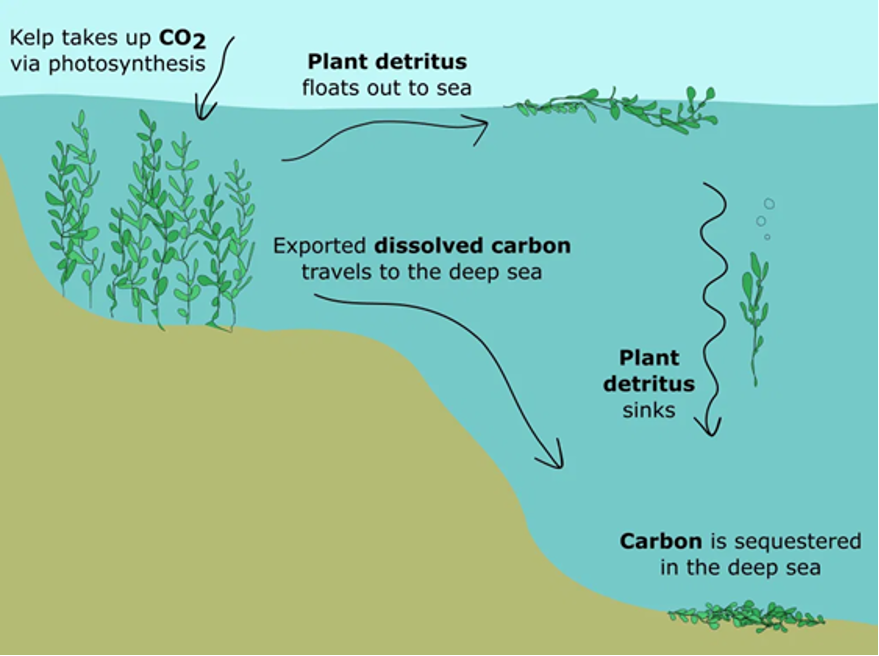Kelp & Climate
As the new President-elect Joe Biden prepares to take office in January, he plans to usher in a new administration and agenda that aims to bring large changes to how America handles climate change. Part of his plan includes “an enforcement mechanism to achieve net-zero emissions no later than 2050” (Plan for Climate Change, 2020). Bringing a nation to net-zero emissions takes more than just talk. It involves compensating for existing carbon dioxide emission sources like cows and industrials, greenhouse gas emitters that won’t simply disappear in the next thirty years. It goes beyond simply reducing our emissions. To accomplish this, we will need to see significant methods of removing these emissions from the atmosphere. One such method, and the focus of this article today, is the farming of kelp.
For many of us, we have only seen kelp as the lumpy piles of brown plant matter that litter the occasional beach. This unassuming plant, however, may be a key component for achieving carbon neutrality in the United States. Kelp, like other plants, converts carbon dioxide from the atmosphere into oxygen and carbon plant matter. This separates the carbon from the air and brings it into a storable solid state. This process is illustrated in the diagram below.
Chung, I. K. (2013) Conceptual schematic diagram of seaweed [Slide] https://academic.oup.com/icesjms/article/70/5/1038/644026
Furthermore, Kelp grows at a rate rivaling bamboo. Kelp has a capacity to grow “up to two feet per day” and is able to be stored or “sequestered” on the ocean floor where it can remain for extreme durations of time (Hurlimann, 2019). This creates a system wherein kelp can be grown quickly in the ocean, harvested, and deposited deep underwater to form a literal carbon sink. Here it can remain, as a far longer-lasting carbon sink than similar alternatives. Trees, for example, will not outlast well-sequestered kelp. If we look to the Amazon or California we see wildfires and deforestation. Wildfires are especially damaging, as all the stored carbon burns and is emitted back into the atmosphere as carbon dioxide. At the bottom of the ocean, kelp is safe to remain for centuries. Most of our world is covered with ocean, this gives us significant space that is currently underutilized and ripe for kelp forests. From the illustration below, we can see this sequestration process in detail. The kelp is grown near a shore, where it can be farmed en masse. Following this, it can be harvested and left to decompose on the ocean floor. This, however, raises the question of why a farmer would grow something only to let it float away.
Zucker, H. (2019) “Adapted from Krause-Jensen and Duarte, 2016” Pathways for sequestration of macroalgae carbon into the deep sea [Digital Image] http://sitn.hms.harvard.edu/flash/2019/how-kelp-naturally-combats-global-climate-change/
What incentives do companies have for growing plants only to leave them to rot? While working to reach carbon neutrality, we can’t assume private companies will pursue this noble goal without a viable market. Luckily, kelp has significant uses beyond just carbon sequestration. According to a case study in the ICES Journal of Marine Science, it can be “harvested to produce biofuels, thereby ensuring that CO2 is not simply recycled back into the air, but instead replaces fossil fuel with renewable fuel” (Ik Kyo Chung, 2013). Rather than drilling for oil, we may turn to biofuels for a net-zero emission energy source. Furthermore, much like seaweed, kelp can be consumed as a food source. While not abundant in the present diet, some consider kelp to be a superfood or part of a new fad diet (La Forge, 2019). These markets have allowed some small scale businesses to develop kelp farms, but not yet on a large enough scale to have a meaningful impact on national carbon emissions. For growing kelp to become a large industry, there need to be several key developments. Things to keep watch for include carbon tax credit initiatives and greater investment into biofuels. A carbon credit system would force large corporations to independently reach carbon neutrality through their own means or by purchasing these “credits” from negative emitters like kelp farmers (Kenton, 2020). The department of energy has already made developments toward this through tax credit 45Q that incentivizes companies to sequester carbon at a rate of $20 per metric ton sequestered in “geologic storage” (US Department of Energy, 2019). If this credit is expanded or reworked, we may see further growth in the kelp industry. Lastly, further incentives or necessity within biofuels will see even greater development in the usage of kelp as a fuel.
In conclusion, this unassuming plant has significant potential as part of a greater climate control initiative. It has a powerful ability to sequester carbon deep underwater for a significant time and is able to capture that carbon quite quickly. Kelp’s usages beyond this will ensure its durability as a farmable good, and private companies seeking sustainable and socially beneficial projects will likely consider kelp in the future.
Bibliography
Hurlimann, S. (2019, July 04). How Kelp Naturally Combats Global Climate Change. Retrieved November 30, 2020, from http://sitn.hms.harvard.edu/flash/2019/how-kelp-naturally-combats-global-climate-change/
Kenton, W. (2020, September 23). How Does the Carbon Credit Work? Retrieved December 09, 2020, from https://www.investopedia.com/terms/c/carbon_credit.asp
La Forge, T. (2019, March 8). How Kelp Can Actually Help You Lose Weight and Balance Your Hormones. Retrieved from https://www.healthline.com/health/food-nutrition/ways-to-eat-kelp-or-seaweed#health-benefits-of-kelp
Plan for Climate Change and Environmental Justice: Joe Biden. (2020, October 29). Retrieved November 30, 2020, from https://joebiden.com/climate-plan/
Ik Kyo Chung, Jung Hyun Oak, Jin Ae Lee, Jong Ahm Shin, Jong Gyu Kim, Kwang-Seok Park, Installing kelp forests/seaweed beds for mitigation and adaptation against global warming: Korean Project Overview, ICES Journal of Marine Science, Volume 70, Issue 5, September 2013, Pages 1038–1044, https://doi.org/10.1093/icesjms/fss206
US Department of Energy | Fossil Energy. (2019, October). Internal Revenue Code Tax Fact Sheet [Brochure]. https://www.energy.gov/sites/prod/files/2019/10/f67/Internal%20Revenue%20Code%20Tax%20Fact%20Sheet.pdf








